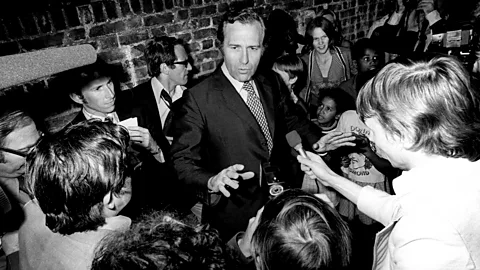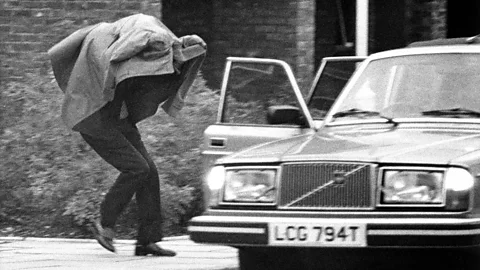
The British politician who was caught faking his own death
 Getty Images
Getty ImagesWhen John Stonehouse’s clothes were found in a pile on Miami Beach on 20 November 1974, many people presumed that the UK Member of Parliament had drowned while swimming – until he turned up alive and well in Australia on Christmas Eve. In History looks at the stranger-than-fiction tale of the man who died twice.
When John Stonehouse hatched his plan to disappear completely, he was a troubled man. His political career had stalled, his dodgy business dealings left him facing financial ruin, he was accused of being a communist spy, and he was having an extra-marital affair with his secretary. In a move borrowed from the Frederick Forsyth novel, The Day of the Jackal, Stonehouse stole the identity of two dead men. He travelled on a business trip to Miami where he vanished, in November 1974, then hopped on another plane to Australia. The ruse lasted just over a month. It was British aristocrat Lord Lucan, another infamous fugitive who disappeared around the same time, who would inadvertently lead him to get caught in Australia.
And how did Stonehouse explain his actions? The British Member of Parliament insisted to the BBC in January 1975 that he was on “a fact-finding tour, not only in terms of geography but in terms of the inner self of a political animal”.
To the British public in the late 1960s, he must have seemed like a man who had it all. Postmaster General at the age of 43, with a glamorous wife and three children, he was talked about as a future Labour prime minister. He was the man who oversaw the introduction of first- and second-class stamps, but for his political career, that role was as good as it got.
The rot began to set in when a defector from communist Czechoslovakia claimed in 1969 that the country had recruited the MP as an informer. Stonehouse protested his innocence to Prime Minister Harold Wilson, who believed him. Such allegations were rife during the Cold War, but Stonehouse’s political reputation was damaged. When the Labour Party lost the 1970 general election, there was no seat for Stonehouse on the opposition front bench. Disillusioned, he decided to devote more time to his London business interests – mostly export services he had developed through his international connections.
In 1971, Bangladesh’s fight for independence from Pakistan fired Stonehouse with fresh enthusiasm. He became emotionally involved in the Bengali cause, becoming such a familiar and sympathetic figure there that when the war ended, he was made a citizen of the new state as a mark of respect. That was only the start.
He was asked to help set up the British Bangladesh Trust, a bank that would provide services for Bengali people in Britain. But the way the bank was being operated later drew critical comment from a Sunday newspaper and attracted investigators from the Fraud Squad and Department of Trade and Industry in London. The bad publicity and these official inquiries frightened away much of the bank’s support, leaving Stonehouse deeply depressed and feeling he was also losing the respect of fellow MPs.
He concocted a plan to escape from it all. First, he forged a passport application in the name of Joseph Arthur Markham, a foundry worker who had recently died in his constituency of Walsall, in England’s West Midlands. He turned this new identity into a globetrotting export consultant with bank accounts in London, Switzerland and Melbourne. He then established another identity in the name of Donald Clive Mildoon, who had also just died in Walsall. To help fund this new life, Stonehouse transferred large amounts of cash from his businesses into a series of bank accounts.
‘A divided personality’
On 20 November 1974, Stonehouse vanished while, it seemed, he was swimming in the sea in Miami, Florida. There was no trace of the 49-year-old apart from the pile of clothes he left behind on the beach. Was he swept away by the ocean? Was he murdered and put inside a concrete block found near Miami Beach? Had he been kidnapped?
His wife Barbara was in no doubt that there had been a tragic accident. She told BBC News: “I’ve heard some extraordinary rumours and they’re all so much out of character with my husband’s personality that they’re just not worth answering or worth thinking about. I’m convinced in my mind that it was a drowning accident. All the evidence that we’ve had points to the fact that he was drowned.”
In London, police had their own suspicions. Sheila Buckley, Stonehouse’s 28-year-old secretary and secret girlfriend, kept insisting to friends that he was dead, but she knew the real story: some of her clothes had been packed in a trunk and shipped to Australia a month before, she had transatlantic telephone calls from him, and she had also sent him semi-coded letters through one of his two Australian banks. It was having those two bank accounts in different names, Markham and Mildoon, that eventually put Melbourne police on his trail. At the time, they were on the lookout for the infamous missing peer Lord Lucan, who coincidentally vanished on 8 November after murdering his children’s nanny. Initially, the police thought that the debonair Englishman spotted signing dodgy cheques might be him.
While Lucan’s disappearance has continued to mystify police for 50 years, the Stonehouse mystery lasted just over a month. On Christmas Eve, Stonehouse had to confess his true identity. Later, at Melbourne police headquarters, he asked whether he could phone his wife in the UK. Although he didn’t realise it then, the telephone conversation in which he made his bombshell revelation to her was taped.
He said: “Hello darling. Well, they picked up the false identity here. You would realise from all this that I have been deceiving you. I’m sorry about that, but in a sense I’m glad it’s all over.” For a few days Stonehouse was kept in a detention centre before being joined in Australia by his family, and later by his girlfriend.
A month after his reappearance, he sat down for an interview with the BBC’s Australia correspondent, Bob Friend. He blamed his actions on having developed a “divided personality, with the new personality providing a release to the old personality, which was under stress and strain of considerable proportions”. Asked how he could put his wife and family through such anguish, he said: “I was trying – by disappearing – to make their lives easier… by taking away some of the tensions that I gave to them from my old personality.”
Stonehouse was still an MP, but rejected any suggestion that he should give up his parliamentary salary while 12,000 miles away from his constituency. He said: “Lots of Members of Parliament go on overseas visits and do fact-finding tours. I’ve been doing a fact-finding tour not only in terms of geography, but in terms of the inner self of a political animal. Now that tour could be very interesting and, my golly, I think it fully justifies an MP’s salary if I can get the story down of my experience.” He added: “I think a Member of Parliament, like anybody else in any other job, is entitled to some consideration during a period when he has some sort of illness.”
You only die twice
For seven months, Stonehouse tried to stay in Australia, but he was eventually deported and escorted back home by Scotland Yard detectives. In August 1976, after a marathon 68-day trial on charges relating to his failed businesses, he was jailed for seven years for theft, fraud and deception offences. He left prison three years later while recovering from open heart surgery, having suffered three cardiac arrests during his time inside.
His wife divorced him in 1978, and three years later he married Buckley, his former secretary. He died for a second time in 1988 – and this time it was for real. The 62-year-old had collapsed three weeks earlier, just before he was due to appear on a television show about missing people.
 Getty Images
Getty ImagesBut what of those espionage claims that so damaged his political career? In his BBC interview after he reappeared, he dismissed as “ludicrous” the idea that he had been a spy for Czechoslovakia. To this day, his daughter Julia rejects any claims that he passed information to foreign powers, and in 2021 she wrote a book in his defence. Cambridge historian Prof Christopher Andrew is one of the few people who have seen MI5’s file on Stonehouse; in his 2009 authorised history of the British intelligence service, he concluded that Stonehouse had indeed spied for the Czechoslovaks.
Speaking in 2012, Prof Andrew told the BBC: “The really decisive evidence came in the mid-1990s when the Czechoslovak intelligence service, having become an ally, made public some of Stonehouse’s file. They were pretty disappointed with the quality of the intelligence he passed on as a minister, so to the long list of people who John Stonehouse defrauded, it is just possible that we can add the name of Czechoslovak intelligence.”
For more stories and never-before-published radio scripts to your inbox, sign up to the In History newsletter, while The Essential List delivers a handpicked selection of features and insights twice a week.





